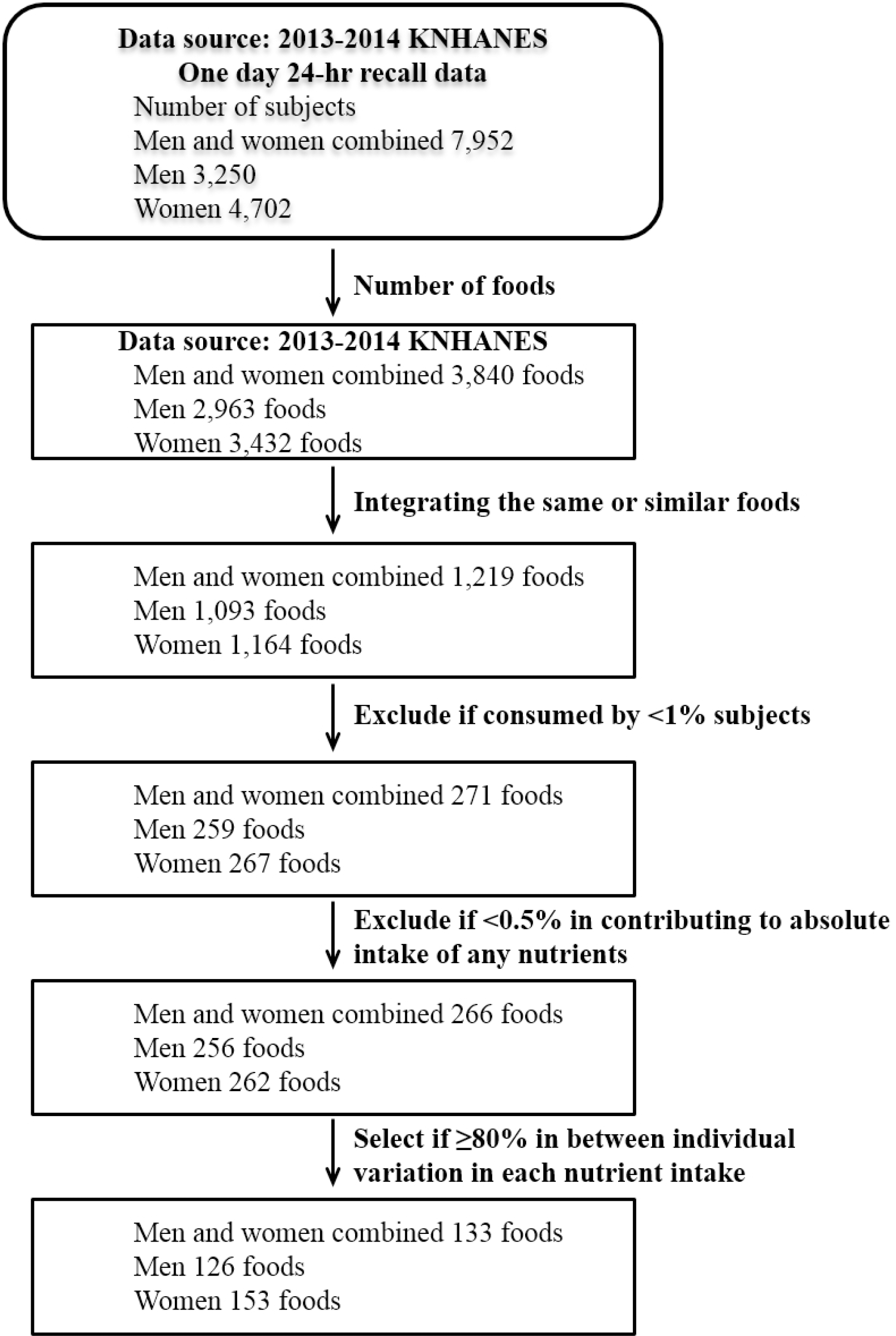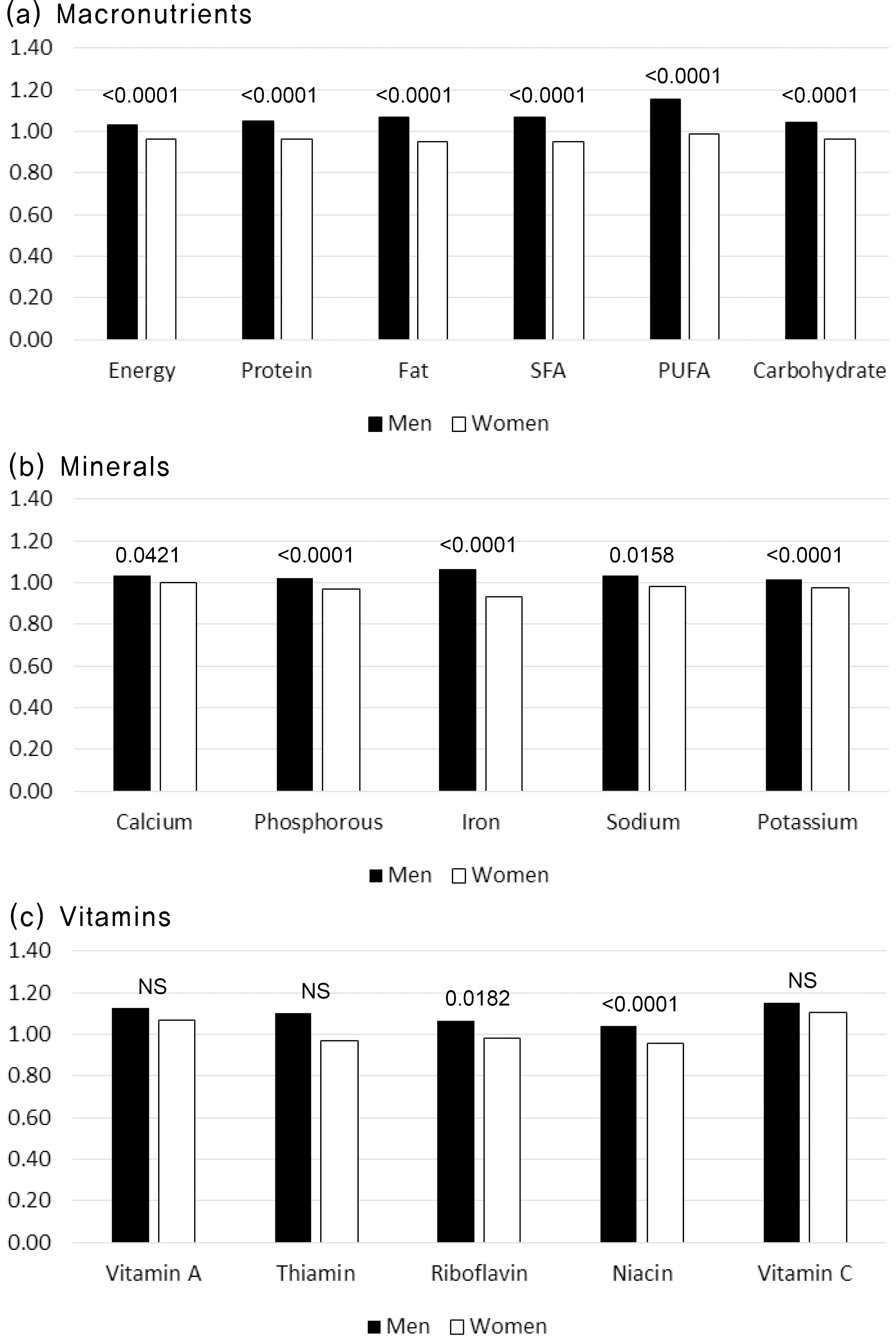Gender Analysis of Food Items Selection for Food Frequency Questionnaire Development
- Minji Kang1, Jung Eun Lee2,3, Jae Eun Shim4,5, Hee-Young Paik1,2,
- Received June 06, 2018 Accepted June 25, 2018
- ABSTRACT
-
- Background
- The aims of this study were 1) to compare foods between men and women with high contributions to absolute intake and the variability in energy and nutrient intakes, which are common criteria of selecting foods for food frequency questionnaire (FFQ), 2) to analyze possible inaccuracies due to not taking gender into consideration.
- Methods
- The study used 1-day 24 hour recall data of 7,952 participants (n=3,250 men, n=4,702 women) aged 19–64 years who participated in the 2013–2014 Korea National Health and Nutrition Examination Survey. Foods which have high possibility of being included in FFQ items, called candidate foods, were selected by analyzing their contribution to absolute intake and variability in the intakes of energy and 15 nutrients in total participants, men and women.
- Results
- The number of candidate foods selected was 133 for total participants, 126 for men, and 153 for women. Intakes of candidate foods for total participants were significantly higher in energy and six nutrients out of selected 16 nutrients than those of candidate foods for men only. On the contrary, all nutrient intakes of candidate foods for total participants were significantly lower than those of candidate foods for women only.
- Conclusions
- Differences were revealed between men and women not only in the total numbers, but also in the selected food items from the candidate foods for FFQ. Thus, developing FFQs without considering gender may produce systematic errors in dietary assessment, possibly in different directions for men and women.
Table 1.
Descriptions of 6th (2013–2014) Korea National Health and Nutrition Examination Survey whose dietary intake data were included in the present study
| Characteristic | Total (n=7,952) | Men (n=3,250) | Women (n=4,702) | Pa |
|---|---|---|---|---|
| Age, y | 43.4±12.4 | 43.3±12.5 | 43.5±12.3 | 0.3736 |
| Age group | ||||
| 19–29 years | 1,237 (15.6) | 523 (16.1) | 714 (15.2) | 0.4030 |
| 30–49 years | 3,830 (48.2) | 1,571 (48.3) | 2,259 (48.0) | |
| 50–64 years | 2,885 (36.3) | 1,156 (35.6) | 1,729 (36.8) | |
| Residential areab | ||||
| Rural | 1,385 (17.4) | 616 (19.0) | 769 (16.4) | 0.0005 |
| City | 2,980 (37.5) | 1,244 (38.3) | 1,736 (36.9) | |
| Metropolitan | 3,587 (45.1) | 1,390 (42.8) | 2,197 (46.7) | |
| Household income, monthly, won | ||||
| ≤2,000,000 | 1,939 (24.5) | 717 (22.2) | 1,222 (26.1) | 0.0009 |
| 2,000,000–3,500,000 | 2,227 (28.1) | 944 (29.2) | 1,283 (27.4) | |
| 3,500,000–5,000,000 | 1,762 (22.3) | 733 (22.6) | 1,029 (22.0) | |
| >5,000,000 | 1,988 (25.1) | 843 (26.0) | 1,145 (24.5) | |
| Education | ||||
| Middle school or less | 1,445 (21.1) | 461 (17.2) | 984 (23.6) | <0.0001 |
| High school | 2,722 (39.7) | 1,081 (40.2) | 1,641 (39.4) | |
| College or more | 2,685 (39.2) | 1,144 (42.6) | 1,541 (37.0) | |
Table 2.
Number of candidate foods selected among total participants, men, and women in the 2013–2014 Korea National Health and Nutrition Examination Surveya
Table 3.
| Nutrient | Men (n=3,249) | Women (n=4,699) | ||
|---|---|---|---|---|
| From candidate foods of total participantsc | From candidate foods of mend | From candidate foods of total participantse | From candidate foods of womenf | |
| Macro nutrients | ||||
| Energy, kcal | 1934.4±929.9 | 1915.6±921.6g | 1343.5±649.7 | 1399.4±660.4g |
| Protein, g | 59.4±40.7 | 59.4±41.3 | 42.3±27.6 | 44.2±28.1g |
| Fat, g | 39.2±37.3 | 38.8±36.8h | 28.0±26.9 | 29.8±27.5g |
| Saturated fatty acid, g | 12.2±12.7 | 12.0±12.4 g | 8.6±9.4 | 9.1±9.6g g |
| Polyunsaturated fatty acid, g | g 9.2±9.3 | 9.0±9.1g g | 6.8±7.4 | 7.1±7.4g g |
| Carbohydrate, g | 284.7±124.7 | 280.6±122.3g | 219.8±105.6 | 228.4±107.2g |
| Minerals | g | g | ||
| Calcium, mg | 392.7±276.7 | 389.3±275.1g | 322.4±253.1 | 332.4±247.4g |
| Phosphorous, mg | 918.7±499.6 | 917.8±503.1 | 703.8±426 | 730.0±429.8g |
| Iron, mg | 14.1±63.5 | 13.7±63.5g | 10.0±6.6 | 11.0±7.1g |
| Sodium, mg | 3240.2±2757.3 | 3303.2±2742.2g | 2187.6±1915 | 2329.4±1950.5g |
| Potassium, mg | 2520.1±1421.7 | 2521.3±1405.3 | 2120.2±1360.4 | 2186.7±1380.1g |
| Vitamins | ||||
| Vitamin A, μgRE | 550.2±642.2 | 526.1±598.2g | 457.8±565.8 | 479.2±579.2g |
| Thiamin, mg Riboflavin, mg | 1.9±1.1 1.2±0.8 | 1.9±1.1 1.2±0.8 | 1.4±0.8 0.9±0.6 | 1.4±0.8g 0.9±0.6g |
| Niacin, mg | 13.6±8.8 | 13.5±9.1 | 10.2±6.5 | 10.7±6.6g |
| Vitamin C, mg | 68.2±97.5 | 71.3±99.6g | 79.9±122.3 | 81.1±122.6g |
aCandidate foods: foods which have high possibility of being included in food frequency questionnaire items, which were identified as foods with high contribution to total energy and major nutrient intakes as well as foods of major sources of between-person variation in energy and nutrient intakes.
bAmong the participants (men, n=3,250; women, n=4,702), those who did not consume the candidate foods (men, n=1; women, n=3) were excluded from the nutrient intake comparison.
- REFERENCES
- REFERENCES
References
1. Block G, Dresser CM, Hartman AM, Carroll MD. Nutrient sources in the American diet: quantitative data from the NHANES II survey. I. Vitamins and minerals. Am J Epidemiol 1985;122(1):13-26.
[PubMed]2. Block G, Dresser CM, Hartman AM, Carroll MD. Nutrient sources in the American diet: quantitative data from the NHANES II survey. II. Macronutrients and fats. Am J Epidemiol 1985;122(1):27-40.
[PubMed]3. Block G, Hartman AM, Dresser CM, Carroll MD, Gannon J, Gardner L. A databased approach to diet questionnaire design and testing. Am J Epidemiol 1986;124(3):453-69.
[Article] [PubMed]4. Stryker WS, Salvini S, Stampfer MJ, Sampson L, Colditz GA, Willett WC. Contributions of specific foods to absolute intake and between-person variation of nutrient consumption. J Am Diet Assoc 1991;91(2):172-8.
[Article] [PubMed]5. Beaton GH, Milner J, Corey P, McGuire V, Cousins M, Stewart E, et al. Sources of variance in 24-hour dietary recall data: implications for nutrition study design and interpretation. Am J Clin Nutr 1979;32(12):2546-59.
[Article] [PubMed]6. Ireland P, Jolley D, Giles G, O'Dea K, Powles J, Rutishauser I, et al. Development of the Melbourne FFQ: a food frequency questionnaire for use in an Australian prospective study involving an ethnically diverse cohort. Asia Pac J Clin Nutr 1994;3(1):19-31.
[PubMed]7. Park MK, Kim DW, Kim J, Park S, Joung H, Song WO, et al. Development of a dish-based, semiquantitative FFQ for the Korean diet and cancer research using a database approach. Br J Nutr 2011;105(7):1065-72.
[Article] [PubMed]8. Hebden L, Kostan E, O'Leary F, Hodge A, Allman-Farinelli M. Validity and reproducibility of a food frequency questionnaire as a measure of recent dietary intake in young adults. PLoS One 2013;8(9):e75156.
[Article] [PubMed] [PMC]9. Lee H, Kang M, Song WO, Shim JE, Paik HY. Gender analysis in the development and validation of FFQ: a systematic review. Br J Nutr 2016;115(4):666-71.
[Article] [PubMed]10. Korea Centers for Disease Control and Prevention. The sixth Korea National Health and Nutrition Examination Survey (KNHANES VI). [Internet]. Sejong: Ministry of Health and Welfare; 2015. [Accessed June 5, 2018]. Available from:. https://knhanes.cdc.go.kr/knhanes/sub02/sub02_03.do.11. Overvad K, Tjønneland A, Haraldsdóttir J, Ewertz M, Jensen OM. Development of a semiquantitative food frequency questionnaire to assess food, energy and nutrient intake in Denmark. Int J Epidemiol 1991;20(4):900-5.
[Article] [PubMed]12. Yum J, Lee S. Development and evaluation of a dish-based semiquantitative food frequency questionnaire for Korean adolescents. Nutr Res Pract 2016;10(4):433-41.
[Article] [PubMed] [PMC]13. Yun SH, Shim JS, Kweon S, Oh K. Development of a food frequency questionnaire for the Korea National Health and Nutrition Examination Survey: data from the fourth Korea National Health and Nutrition Examination Survey (KNHANES IV). Korean J Nutr 2013;46(2):186-96.
[Article]14. Kang M, Jung HJ, Joung H, Shim JE, Lee SE, Park YH, et al. Development of Han-sik database utilizing an expert focus group and assessment of Han-sik effects on diet quality. Korean J Food culture 2014;29(1):9-17.
[Article]15. Cade J, Thompson R, Burley V, Warm D. Development, validation and utilisation of food-frequency questionnaires – a review. Public Health Nutr 2002;5(4):567-87.
[Article] [PubMed]16. Block G, Hartman AM, Naughton D. A reduced dietary questionnaire: development and validation. Epidemiology 1990;1(1):58-64.
[Article] [PubMed]17. Drewnowski A, Henderson SA, Shore AB, Fischler C, Preziosi P, Hercberg S. Diet quality and dietary diversity in France: implications for the French paradox. J Am Diet Assoc 1996;96(7):663-9.
[PubMed]18. Jayawardena R, Byrne NM, Soares MJ, Katulanda P, Yadav B, Hills AP. High dietary diversity is associated with obesity in Sri Lankan adults: an evaluation of three dietary scores. BMC Public Health 2013;13:314-21.
[Article] [PubMed] [PMC]19. Kim CW, Kim TH. Study on the food selection by analyzing the correlates of perceptions and consumptions frequency of foods. Korean J Food Culture 2004;19(5):524-31.20. Hong YH. A study of dietary pattern and food preference of unversity students in Gwangju and Chonnam province. Korean J Food Culture 2008;23(3):318-27.21. Blanck HM, Gillespie C, Kimmons JE, Seymour JD, Serdula MK. Trends in fruit and vegetable consumption among U.S. men and women, 1994–2005. Prev Chronic Dis 2008;5(2):1-10.22. Fagerli RA, Wandel M. Gender differences in opinions and practices with regard to a "healthy diet". Appetite 1999;32(2):171-90.
[Article] [PubMed]23. Bates CJ, Prentice A, Finch S. Gender differences in food and nutrient intakes and status indices from the National Diet and Nutrition Survey of people aged 65 years and over. Eur J Clin Nutr 1999;53(9):694-9.
[Article] [PubMed]24. Noh H, Park MK, Lee H, Kim J, Joung H, Paik HY. Reanalyzing sex/gender specific portion sizes of dish items for a dish-based, semiquantitative FFQ for Korean adults. Gender Summit 4 in Europe;. 2014;June 30 – July 01; Brussels..25. Nishi N, Horikawa C, Murayama N. Characteristics of food group intake by household income in the National Health and Nutrition Survey, Japan. Asia Pac J Clin Nutr 2017;26(1):156-9.
[PubMed]


